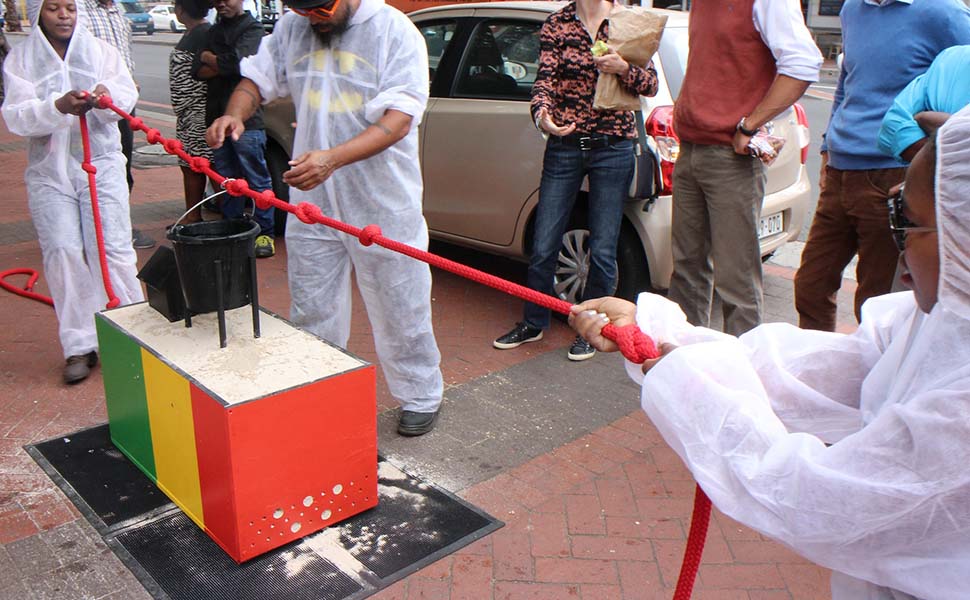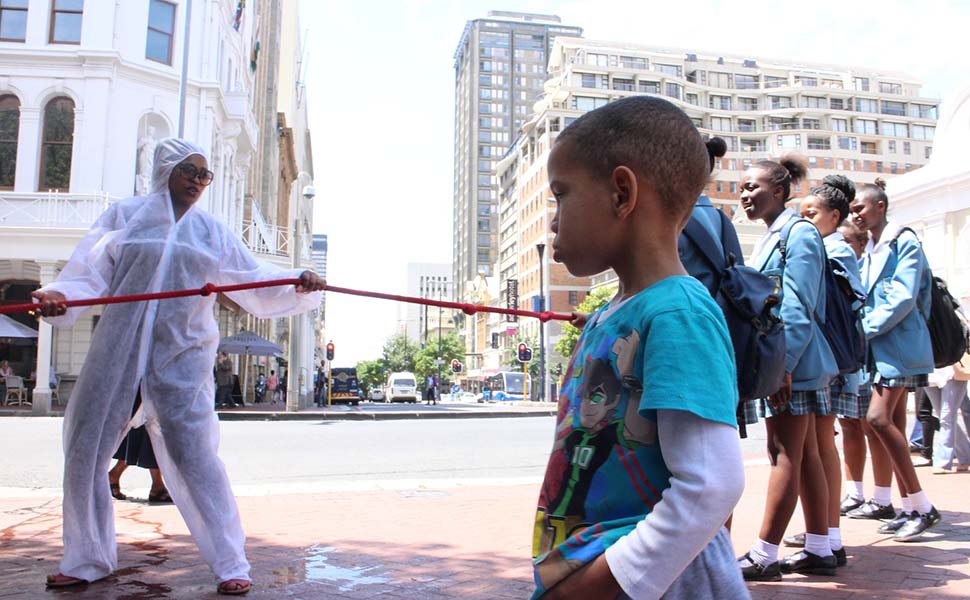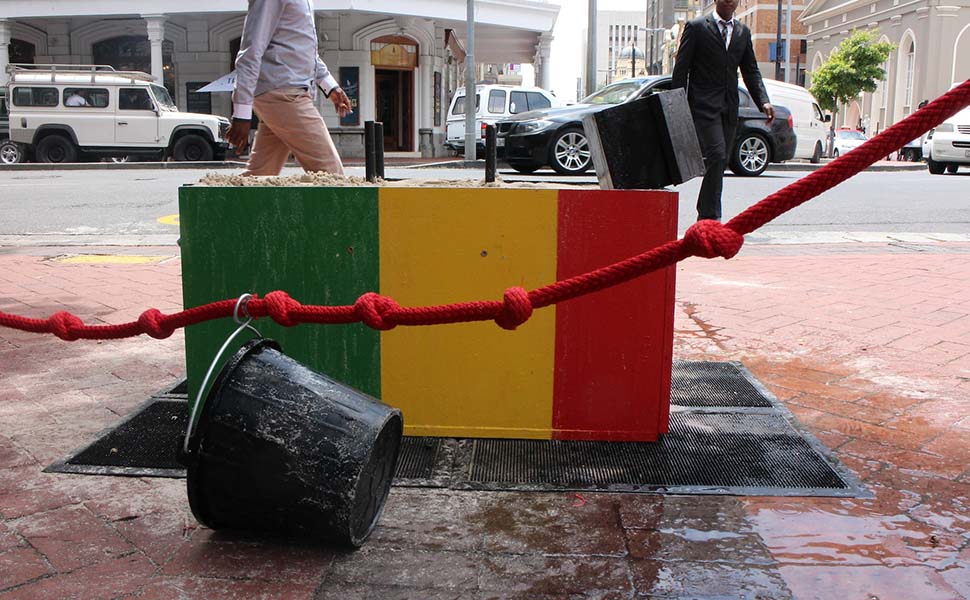
Serious fun: a tug-of-war over Cape Town’s coastline in light of a changing climate
Climate change can be a tricky topic to engage with at the best of times, for at least three reasons. Writes Anna Taylor, an embedded researcher and participant of the Knowledge Transfer Programme in Cape Town.
Firstly, climate change is multi-facetted – relating to everything from carbon dioxide and methane concentrations in the atmosphere, through landfills, coal-fired power stations and solar water heaters on roofs, to flood risk, crop yields, forest fires, heat stroke, sea levels, storm surges and so much more;
Secondly, climate change crosses many scales – it occurs and is scientifically detected globally but it is produced and experienced locally; it is happening now, but it plays out over long time periods, having begun with the Industrial Revolution and with model-based projections of the future climate looking ahead to 2100.
Thirdly, climate change is about both the environment and society – it is detected, monitored and projected by natural scientists using complex methods and often communicated in technical terms pertaining to the environment, but both its drivers and its impacts are at the heart of our social and economic systems, which generates much political controversy.
Complexity alienates people
These three aspects of climate change have alienated many people from the topic. But because climate change relates to so many aspects of our lives, it is critical that we have more and wider public engagement and sense-making around the implications of climate change and the choices we make or the choices that get made on our behalf. This is where games and some serious fun come in. Games can provide a playful way for people to engage with new ideas and possibly arrive at new perspectives and insights. As Walter Benjamin said: “…there is no better starting point for thought than laughter. In particular, thought usually has a better chance when one is shaken by laughter than when one’s mind is shaken and upset.”
Using games to communicate the risks of climate change
As part of the City Desired exhibition mounted by the African Centre for Cities (ACC), in collaboration with the City of Cape Town and Mistra Urban Futures being one of various other partners, a series of games have been designed and played to tackle key issues facing the city, one of which is climate change. Working with colleagues from dala, an interdisciplinary collective using various forms of creativity to build safer and more liveable cities, the inspiration for a game came out of research investigating the risks that climate change, specifically sea level rise, pose along Cape Town’s coastline.
The work explored the changing nature and extent of coastal risk linked to further encroachment by the sea, the costs and values associated with building and maintaining private property and public infrastructure (like roads, railways and pump stations) along the coast, and the gradual degradation of coastal ecosystems (like dunes and wetlands) that play an important role in protecting built infrastructure from the impacts of high and stormy seas. The research investigated the process of delineating and enforcing a coastal setback line as a way of limiting additional development in the coastal zone and protecting the functioning of coastal ecosystems in order to manage the increasing risks associated with sea level rise.
A tug-of-war game
This gave rise to the idea of a tug-of-war over the coastline, capturing the sense of this tension between forces wanting to enable further urban development and the construction of more infrastructure along the coast and others wanting to see some spaces protected for rehabilitating natural coastal buffer zones, especially in light of rising sea levels and bigger storm surges under climate change.
The tug-of-war game involved a red rope representing Cape Town’s coastline, of proportional length to the 307 kilometers of coast that falls within the City of Cape Town municipality. The rope had 19 knots in it to represent the hotspots of high risk from inundation and erosion damage by the sea that had been identified in the research. In the center of the rope was suspended a bucket of water over a box of sand painted red, yellow and green indicating the levels of risk associated with three scenarios of sea level rise. A wooden house or building was placed on the sand that got wet, subsided or fell over altogether when the bucket was tipped due to tugging on the rope.
Engaging community
The game was staged on Tuesday 11 November at the top of Adderley Street, at the entrance to the Company Gardens in the central city, with lots of passing foot traffic, including high school students, local office workers, stall holders, street people and tourists. People looked on as actors (and Mistra Urban Futures researchers!) engaged in the tug-of-war, curious to find out what was going on. Some joined in, eager to beat their friends and colleagues on the other side. The researchers and actors were at hand to discuss with onlookers and participants what the game was about. Also, a booklet entitled “Cape of Storms: Sharing the coast in the face of turbulent, rising seas” that summarizes the main findings of the research was made available to those that expressed an interest in learning more about the issues portrayed in the game.
Video: Climate For Change
See a short video about the game.
Reflections
Reflecting on the process of designing and playing the game, three lessons that I learned are:
1. As academics and researchers, especially dealing with the natural sciences, we have a strong tendency towards very literal forms of communication. We get caught up in detailed explanations and rely on technical jargon, appealing to people’s analytical minds and trying to convince them with evidence. That mode of communication is difficult for us to let go of and yet it is often not very effective in connecting people on the street, nor affective in terms of connecting with people’s attitudes and feelings towards an issue like climate change or coastal management.
2. What is great about working with artists and creative people is their skill at seeing through the detail to capture and convey the essence of the issue that connects with people in a more visceral way, on a more emotional level.
3. Playing the game was a powerful way of raising curiosity, of drawing people into a space of interaction, of opening up opportunities for engagement and possibly generating new insights. But the transition from intrigue and playfulness (only vaguely intimating at the issues) to a deeper engagement with the issues underlying the game is a tricky one that requires both a depth of knowledge, skill and preparation on the one hand and an openness, empathy and adaptability on the other – fertile ground for more collaboration between those working in the arts and the sciences!

